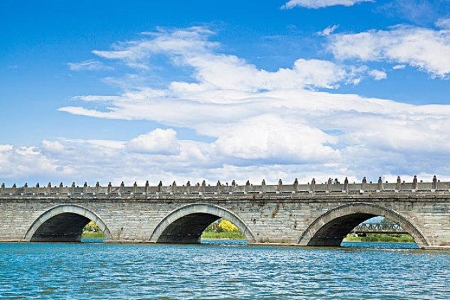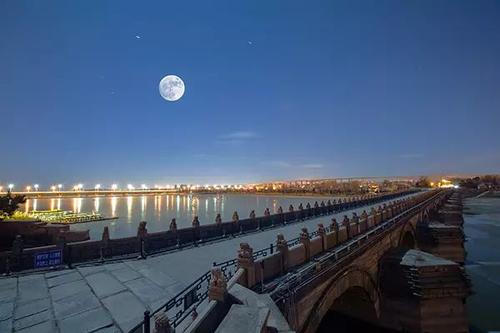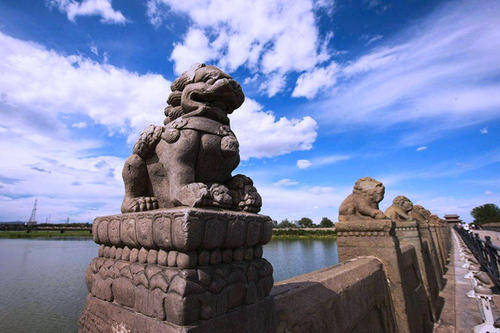Chinese Name: 卢沟桥 Pronunciation: Lúgōu Qiáo
Length: 266.5 meters
Width: 7.5 meters
Building Time: 1189-1192
Recommended Time for Visit: 1 Hour
Address: Chengnan Street, Fengtai District, Beijing, China
Building Function: The bridge was built to promote the economy and facilitate transportation.
| Tickets | Price |
| Adults | 20 yuan |
| Seniors (aged 60-65 years old with ID cards) |
10 yuan |
1. Seniors over 65 years with valid ID card are free of charge.
2. Children under 1.3 meters are free of charge.
| Content | April 1st to October 31st | November 1st to March 31st |
| Opening time | 7:00-20:00 | 7:00-18:00 |

Lugou Bridge, also called Marco Polo Bridge, is a national AAAA-level tourist attraction, a national key cultural relic protection unit, a classic red tourism scenic spot, and a patriotism education base. The bridge, about 15 kilometers southwest of Beijing, is the longest ancient stone bridge in the north of China. The Italian traveler Marco Polo was surprised to see Lugou Bridge and praised it as “the best and unique bridge in the world”, which is why it is called “Marco Polo Bridge” abroad.
The total body of the bridge is made of stone. The pier construction method of the bridge is quite distinctive. The piers are similar to a flat-bottomed boat. At the front end of each starling, triangular cast iron is installed to divide the water and break the ice so as to protect the piers.
The stone carvings on Lugou Bridge are very exquisite. There are 281 pillars in total on the stone guardrails of the bridge body. The pillars and slab stones are carved with exquisite flower patterns and stone lions in various shapes. Therefore, there is a proverb saying that you can never count the stone lions at Lugou Bridge.
From 1189 to 1192, Lugou Bridge was built.
In 1751, Emperor Qianlong of the Qing Dynasty (1636-1912) ordered to erect a stele with four Chinese characters “Lu Gou Xiao Yue” (that is, Moonlit Lugou Bridge at Dawn) on the bridge.
In 1961, Lugou Bridge was included in the first batch of national key cultural relics protection units.
In 1986, the Lugou Bridge Historical and Cultural Relics Restoration Committee was established with the purpose of restoring the original appearance of Lugou Bridge.
In 2017, the digital archive of stone lions at Lugou Bridge was built to show Lugou Bridge in a panoramic view.

The stele with the four Chinese characters “Lu Gou Xiao Yue” was set by Emperor Qianlong of the Qing Dynasty because the moon sight at Lugou Bridge is famous for the bright and clear moonshine. The scene has been well known in China since the Jin Dynasty (1115-1234).
There are 11 arches in Lugou Bridge. The carvings on the arches are very exquisite. The stones of the arches are all reinforced with iron and copper, and the inside of the piers are also connected by iron to make it stable for thousands of years, which is rare to see in the Chinese history of stone bridge architecture.

The postures of the stone lions built in different dynasties are different.
As for stone lions built during both the Jin Dynasty and the Yuan Dynasty (1271-1368), the bodies of the stone lions are relatively slender. Their mouths are upturned and slightly open but are not hollowed out totally. You can also see a small bell in the front of the stone lions’ heads.
As for those built in the Ming Dynasty (1368-1644), they are slightly stubby and short, with their feet on hydrangea or small lions. The lions’ mouths are open, big, and square, with an empty center. Their tongues are licking upwards.
As for those built in the Qing Dynasty, you can see small lions on the stone lions’ bodies. The stone lions at that time are not as fierce as before, and carvings patterns on their bodies, as well as the patterns on the bells, are very delicate.
As for those built in and after the late Qing Dynasty, they are carved lightly and randomly as the curls on the back of the lions’ heads become larger. Their mouths, noses, and eyes are carved without any specific proportions.
There is an old story about the moon at Lugou Bridge in ancient China. When the moon went down, you could see the bright moon reflected in the water. The moon became more beautiful and brilliant, attracting many people to appreciate the moon on the scene. As a result, “Moonlit Lugou Bridge at Dawn” was listed as one of the “Eight Great Sights in Yanjing City” (Beijing was previously known as Yanjing) during the Jin Dynasty.
Take bus 309, 329, 339, 458, 459, 624 or 952, get off at Lugou Xinqiao Station, and walk toward southwest about 80 meters along the Lugou Bridge South Road, turn right, walk about 70 meters along the Chengnan Street, turn left, walk about 610 meters, turn left, walk about 360 meters to the Lugou Bridge.
Chinese: 请带我去卢沟桥。English: Please take me to Lugou Bridge.
If you go to Lugou Bridge from the center of Beijing (Grand Hyatt Beijing), it takes about 40 minutes (about 65 yuan).
If you go to Lugou Bridge from Beijing Capital International Airport, it takes about 1 hour (about 175 yuan).
If you go to Lugou Bridge from Beijing Daxing International Airport, it takes about 50 minutes (about 170 yuan).
If you go to Lugou Bridge from Beijing West Railway Station, it takes about 20 minutes (about 35 yuan). (929 words)
